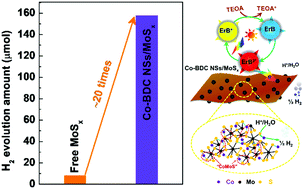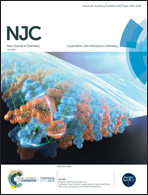In situ growth and activation of an amorphous MoSx catalyst on Co-containing metal–organic framework nanosheets for highly efficient dye-sensitized H2 evolution†
Abstract
In situ grown amorphous molybdenum sulfide (MoSx) catalysts obtained by a photoreduction method have shown photocatalytic H2 evolution activity comparable to noble metals; however, the activity of the MoSx catalysts is still low due to the inevitable aggregation and the low intrinsic activity of active sites. Here, we report that in situ growth and activation of MoSx on ultrathin Co-containing metal–organic framework nanosheets (Co-BDC NSs, BDC: 1,4-benzenedicarboxylic acid) leads to the formation of a highly active H2 evolution catalyst (Co-BDC NSs/MoSx) in an erythrosin B-triethanolamine (ErB–TEOA) system under visible light irradiation (λ ≥ 450 nm). During the photochemical synthesis of the Co-BDC NSs/MoSx catalyst, the ultrathin Co-BDC NSs can not only provide a large surface area to effectively anchor MoSx nanoparticles with a reduced size and a high dispersion, but also afford abundant coordinatively unsaturated and active Co sites to form highly active “CoMoS” sites; as a result, the Co-BDC NSs/MoSx catalyst exhibits a ∼20 times higher H2 evolution activity than free MoSx and an apparent quantum yield (AQY) of 15.0% at 500 nm. This work presents an efficient strategy to design highly efficient MoSx-based hybrid catalysts for solar photocatalytic H2 evolution reactions.



 Please wait while we load your content...
Please wait while we load your content...